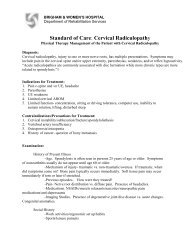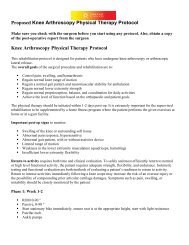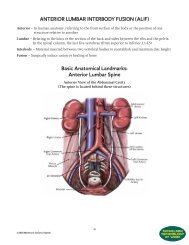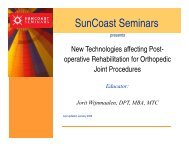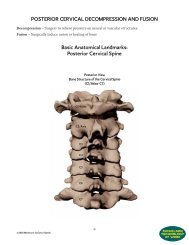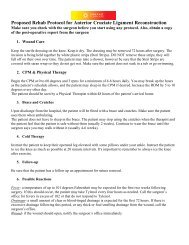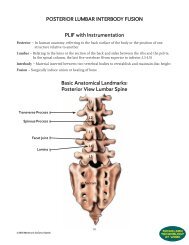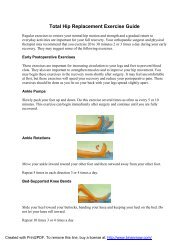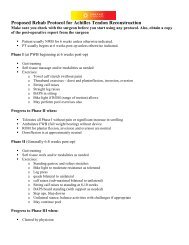PCL Repair Protocol - Suncoastseminars.com
PCL Repair Protocol - Suncoastseminars.com
PCL Repair Protocol - Suncoastseminars.com
You also want an ePaper? Increase the reach of your titles
YUMPU automatically turns print PDFs into web optimized ePapers that Google loves.
Proposed Rehab <strong>Protocol</strong> for Posterior Cruciate Ligament ReconstructionMake sure you check with the surgeon before you start using any protocol. Also, obtain a copyof the post-operative report from the surgeonPost-Operative Instructions for Posterior Cruciate Ligament Reconstruction1. Wound CareYou have a sterile dressing on your knee. Keep it dry. You may remove this dressing 72 hours after surgery.Your incision is being held together by white plastic strips (Steri Strips). DO NOT remove these strips; theywill fall off on their own over time. You may take a shower, however be sure to cover the Steri Strips withsaran wrap so they do not get wet. Do not soak in a tub or go swimming.2. CPM & Physical Therapy• Start CPM at 0 to 60 degrees and 3 rpms for a minimum of 4-6 hours daily.• Hours may be broken as the patients schedule allows.• The patient may sleep in the CPM if desired.• Increase the ROM by 5 to 10 degrees every other day.• The Physical Therapist will see you within 48 hours of your arrival home.• The Therapist will follow the <strong>PCL</strong> protocol given to you in the hospital.3. Brace and Crutches• Upon discharge from the hospital, the patient will be fitted with a brace and crutches.• Be sure that your patient uses the brace when ambulating.• The patient will HAVE to sleep in the brace for the first 8 weeks.4. Cold Therapy• Keep the operated leg elevated with a pillow under the calf at rest to prevent posterior sag.• Ice the knee as much as possible at 20 minute intervals.• It's important to remember to always ice the knee after exercise.5. Follow-up• Be sure that the patient has a follow up appointment for a wound check about 2 weeks after surgery.Possible Reactions• Fever- a temperature of up to 101.5 degrees Fahrenheit is expected for the first two weeksfollowing surgery. If this should occur, take Tylenol every four hours as needed. Call thesurgeon’s office for fevers in excess of 102 or that do not respond to Tylenol.
Proposed Rehab <strong>Protocol</strong> for Posterior Cruciate Ligament Reconstruction• Drainage- a small amount of clear or blood-tinged drainage is expected for the first 72 hours.If you have excessive drainage following this period, or any thick or foul smelling drainagefrom the wound, call the surgeon’s office.• Wound- if your wound should open, notify the surgeon’s office immediately• Swelling- you may experience swelling for many months after the surgery. This normal.During the first two weeks post-op, the swelling from the knee may gradually travel down tothe calf and ankle. This is to be expected, as an effect of gravity.ISOLATED AND COMBINED <strong>PCL</strong> RECONSTRUCTION POST-OP REHABILITATIONPROTOCOLGENERAL PRINCIPLES• No open chain hamstring work• Assume 8 weeks for graft to bone healing time• Caution against posterior tibial translation (gravity, muscle action)• CPM 0-60 to start• <strong>PCL</strong> with posterolateral corner or LCL repair follows different post-op care, i.e., crutches x 3 months• Supervised physical therapy takes place for approximately 3-5 months post-op.GENERAL PROGRSSION OF ACTIVITIES OF DAILY LIVING (ADLs)Patients may begin the following activities at the post-op dates listed (unless otherwisespecified by the physician):• Bathing/Showering without brace (surgical incisions should be healed before immersion in water) – 1week post-op• Sleep without brace – 8 weeks post-op• Driving – 6-8 weeks post-op• Full weight bearing without assistive devices – 8 weeks post-op (with physician• clearance)PHYSICAL THERAPY ATTENDANCEThe following is an approximate schedule for supervised physical therapy visits:• Frequency:o 0 to 1 month: 1 x weeko 1 to 3 months: 2-3 x weeko 3 to 9 months: 2 x montho 9 to 12 months: 1 x monthREHABILITATION PROGRESSION0 - 1 WEEK POST-OP
Proposed Rehab <strong>Protocol</strong> for Posterior Cruciate Ligament Reconstruction• Brace: Locked at 0-60maximum• Weight bearing Status: WBAT with crutches, with brace locked• Special Considerations: Pillow under proximal posterior tibia at rest to prevent posterior sag• Therapy: Quad Sets Ankle Pumps• SLR Hip Alphabets• Hip AB/AD7-28 DAYS POST-OP• Brace: Locked except for protected range of motion performed by physical therapist.• WB Status: WBAT with crutches, with brace locked- Special Considerations: Continue use of pillow under tibia at rest.• Therapy: PT Assisted knee flexion• For <strong>PCL</strong> only patients: Maintain anterior pressure on proximal tibia as knee is flexed.• For <strong>com</strong>bined <strong>PCL</strong>/ACL patients, maintain neutral position of proximal tibia as knee is flexed.• It is important to prevent posterior tibial sagging at all times.- Hamstring and Calf stretching- Calf press with Theraband- Standing calf raises with full knee extension- Standing hip extension from neutral- Continue exercises as above4-8 WEEKS• Brace: 4-8 weeks: Brace is unlocked for supervised gait training only (patients must be under thedirect supervision of a PT)• WB status: WBAT with crutches• Therapeutic exerciseso When patient exhibits independent quad control, may begin open chain extension, if no flexioncontracture exists.o Wall slides (0to 45)• Begin isometric, progress to active against body weight.o Ambulation in pool (only while in physical therapy)o Continue to maintain hamstring flexibility8-12 WEEKS• D/C Brace 8 weeks• WB status: Wean off crutches at 8 weeks post-op• May D/C crutches if patient exhibits:• No quad lag with SLR• Full knee extension• Knee flexion 90-100• Normal gait pattern• Therapy: Stationary bike: Foot forward on pedal (no toe clips), seat high
Proposed Rehab <strong>Protocol</strong> for Posterior Cruciate Ligament Reconstruction• Balance and proprioception• Seated calf raises• Leg press (within available range of motion)12 WEEKS (3 MONTHS)• Progress functional and symptomatically• Therapy: Treadmill walking• Jogging in pool with• Swimmingo no breaststrokeo emphasize flutter kick from hip (minimize active• knee flexion)3-6 MONTHS• Reduce frequency of physical therapy sessions.• Pt may continue therapy at gym club if released by physician.• During this phase the patient should check in with the supervising physical therapist once every 2weeks.6-12 MONTHS• Return to full activity per MD release and testing shows surgical side quad strength at least 90% ofunoperated side. (e.g. Return to work based on function capabilities)• Sports specific functional progressiono Nordic Tracko Jog/Run progressiono Backward running, Cutting Jumping (Plyometrics)NO SQUATS OR LUNGES AT ANY TIME!




